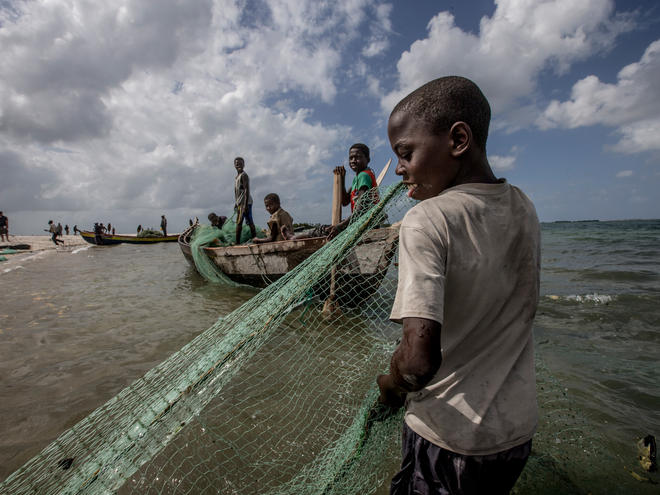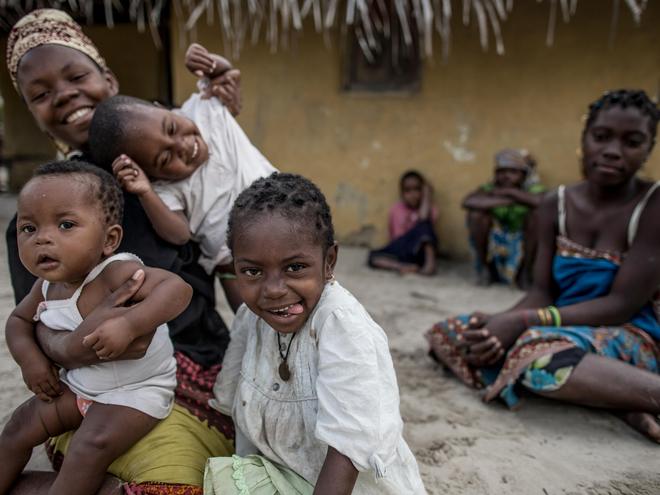

It’s still early in the morning as our small boat speeds across a sea of brilliantly blue water. Bouts of pounding rain have kept us on shore in the city of Angoche for days, but with clearer clear skies and calmer seas, our small group—a team of researchers and conservationists from WWF and CARE—can finally make its way to Pulizica, a small fishing community in Mozambique’s Primeiras e Segundas archipelago.
Pulizica is home to the newest fish sanctuary established by the WWF-CARE Alliance, a global partnership to address the root causes of poverty and environmental degradation, and today we’re seeing how well the protected area is recovering declining fish stocks in the region. As one of three community-governed, no-take fishing zones in the area, the Pulizica sanctuary is part of larger efforts by the Alliance to improve local livelihoods by helping communities better manage their natural resources.
Spanning 4,020 square miles, Premeiras e Segundas is a coastal marine reserve comprised of 10 barrier islands, mangrove forests, coastal estuaries, coral reef complexes, and seagrass beds—all of which support an astonishing array of species. Mozambique’s largest concentration of endangered green, hawksbill, and olive ridley turtles swim in these waters, alongside everything from tropical fish to dugongs.
And the 340,000 people who live in the region are intimately tied to the land and sea as well; about two-thirds of households depend on the archipelago’s diverse fisheries for food and income.
Unfortunately, once plentiful fish stocks in Premeiras e Segundas have declined rapidly in the last decade, largely due to overfishing and poorly managed resources. Coastal communities are now plagued by increasingly unreliable sources of income and chronic food insecurity, putting already strained marine ecosystems under even more pressure.
The no-fishing paradox
The idea of not fishing to catch more fish seems contradictory. But when done right, no-take zones—areas in which people cannot fish—can help recover ocean life. Such sanctuaries protect fragile reefs and prevent fishers from hauling in the wrong species of fish or fish that are too young, giving fisheries the chance to repopulate and grow.
And it works. In Pulizica, the abundance and size of fish in the no-take zone greatly increased, and the diversity of species tripled.
Local fishers support the sanctuaries, too. At least 10 boats sit just outside the zone as we pass by, waiting for the falling tide to bring fish swimming into their nets, which was once an unthinkable occurrence.
We stop to chat with the community monitors who ensure that no one fishes illegally. One says he spotted dolphins in the estuary for the first time in years—a sign that recovering fish stocks are again abundant enough to attract larger predators.
These conversations are good reminders that community-protected, no-take zones aren’t just effective conservation tools; they’re also learning tools that help people understand that better ecosystem management can improve their lives, and that their actions make a difference.
Word about the success of fish sanctuaries has spread along the coastline, and WWF and CARE are now collaborating with the Mozambican government and local communities to enforce no-take zones in the coral reef ringing the Primeiras e Segundas islands. With the help of fishers who have seen these sanctuaries succeed, we’re showing that choosing not to fish—and turning to farming or other alternatives for income instead—can benefit both people and wildlife. Their voices and actions can drive change and ensure the survival of this unique and vital place.
Published September 11, 2018 at 05:00AM
No comments:
Post a Comment